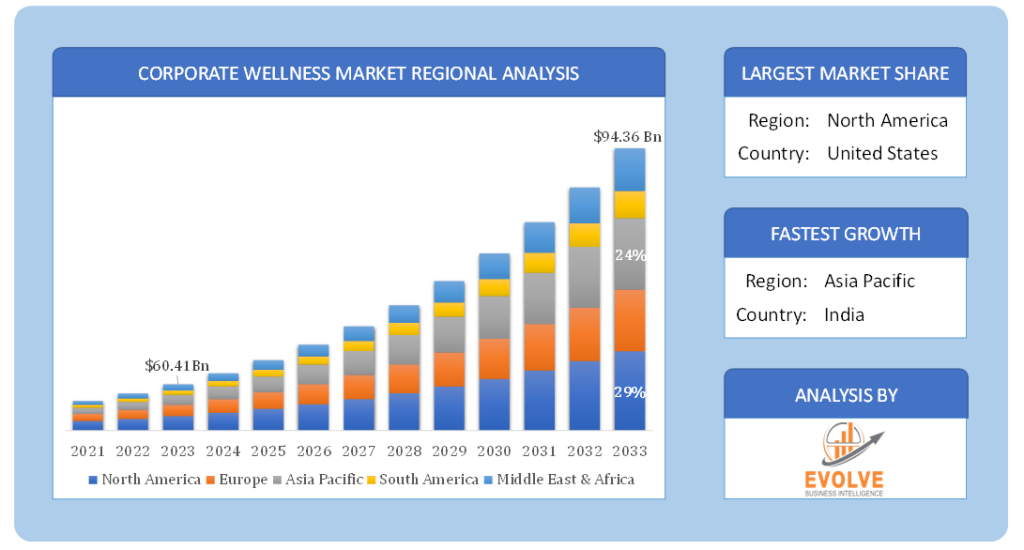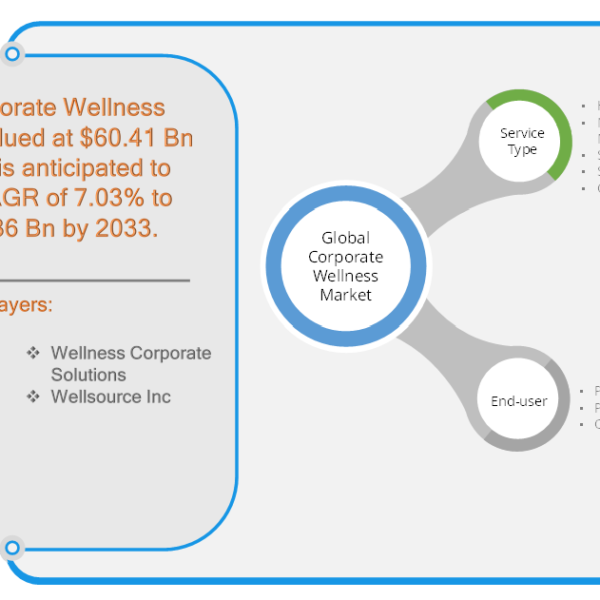Corporate Wellness Market Analysis and Global Forecast 2023-2033
$1,390.00 – $5,520.00Price range: $1,390.00 through $5,520.00
Corporate Wellness Market Research Report: Information By Service Type (Health Risk Assessment, Nutrition and Weight Management, Stress Management, Smoking Cessation, Other), By End-user (Private Sector, Public Sector, Other), and by Region — Forecast till 2033
[vc_row][vc_column width=”2/3″][vc_column_text woodmart_inline=”no” text_larger=”no”]
Corporate Wellness Market Overview
The Corporate Wellness Market Size is expected to reach USD 94.36 Billion by 2033. The Corporate Wellness industry size accounted for USD 60.41 Billion in 2023 and is expected to expand at a compound annual growth rate (CAGR) of 7.03% from 2023 to 2033. Corporate Wellness refers to the strategic initiatives and programs implemented by organizations to promote and improve the physical, mental, and emotional well-being of their employees. It encompasses a wide range of activities, policies, and benefits designed to support employees’ overall health, prevent illness and injury, and foster a positive work environment. Corporate Wellness programs typically include components such as health screenings, fitness, and nutrition programs, stress management initiatives, mental health support, ergonomic assessments, employee assistance programs, and health education. These initiatives aim to enhance employee productivity, reduce healthcare costs, increase employee engagement and satisfaction, and create a culture of wellness within the organization.
Global Corporate Wellness Market Synopsis
The COVID-19 pandemic had a significant impact on the Corporate Wellness market, bringing about both challenges and opportunities. The pandemic highlighted the importance of employee health and well-being, leading organizations to prioritize and invest in comprehensive wellness programs. Remote work arrangements and social distancing measures necessitated the adaptation of wellness initiatives to virtual platforms, with an increased focus on mental health support, stress management, and remote fitness options. Additionally, the pandemic accelerated the adoption of digital health technologies and telemedicine solutions, enabling organizations to provide virtual healthcare services and remote monitoring to employees. On the other hand, the economic uncertainties and financial constraints brought about by the pandemic led some organizations to reduce or reallocate their wellness budgets, impacting the growth of the Corporate Wellness market. However, the long-term effects of the pandemic have underscored the importance of employee well-being, positioning Corporate Wellness as a vital aspect of organizational culture and workforce management moving forward.
Corporate Wellness Market Dynamics
The major factors that have impacted the growth of Corporate Wellness are as follows:
Drivers:
Increasing focus on employee well-being and productivity
Organizations are recognizing the link between employee well-being and productivity. They understand that healthier and happier employees are more engaged, perform better, and have lower absenteeism rates. As a result, there is a growing driver for organizations to invest in Corporate Wellness programs to improve employee well-being, reduce healthcare costs, and enhance overall productivity.
Restraint:
- Budget constraints and ROI concerns
One of the primary restraints for the Corporate Wellness market is the budget constraints and concerns about return on investment (ROI). Some organizations may hesitate to allocate significant resources to wellness programs, especially if they are unsure about the tangible benefits and financial returns. Demonstrating the measurable impact of wellness initiatives on employee health outcomes and organizational performance is crucial to overcoming this restraint.
Opportunity:
Technological advancements and digital solutions
The advancement of technology presents an opportunity for the Corporate Wellness market. Digital platforms, wearable devices, mobile applications, and telehealth solutions enable organizations to deliver personalized wellness programs, track employee health metrics, provide remote support, and offer accessible resources. These technological advancements enhance the engagement, convenience, and scalability of Corporate Wellness programs, making them more appealing and effective for employees and employers alike. Additionally, data analytics and artificial intelligence (AI) can provide valuable insights and predictive analytics to optimize wellness initiatives and improve outcomes.
Corporate Wellness Segment Overview
By Service Type
Based on Service Type, the market is segmented based on Health Risk Assessment, Nutrition and Weight Management, Stress Management, Smoking Cessation, Other. The Health Risk Assessment segment is expected to witness significant growth during the forecast period. Health Risk Assessment involves the evaluation of an individual’s health status, lifestyle factors, and potential health risks through surveys, questionnaires, and biometric screenings. This segment is anticipated to grow due to the increasing emphasis on preventive healthcare and proactive management of employee well-being. Organizations recognize the importance of early identification of health risks and promoting healthy behaviors to mitigate potential health issues. Additionally, advancements in technology, such as online assessments and data analytics, make it easier to conduct and analyze health risk assessments, contributing to the growth of this segment in the Corporate Wellness market.
By End-user
Based on End-user, the market has been divided into Private Sector, Public Sector, and Others. The Private Sector dominates the Corporate Wellness Market. Private sector organizations have more flexibility and resources to invest in comprehensive wellness programs for their employees. They have the autonomy to develop and implement tailored wellness initiatives that align with their organizational goals and culture. Private sector companies often view Corporate Wellness as a strategic investment in their workforce, recognizing the potential benefits of improved employee well-being on productivity, engagement, and retention.
Global Corporate Wellness Market Regional Analysis
Based on region, the global Corporate Wellness market has been divided into North America, Europe, Asia-Pacific, the Middle East & Africa, and Latin America. North America is projected to dominate the use of the Corporate Wellness market followed by the Asia-Pacific and Europe regions.
 North America Market
North America Market
North America has held a dominant position in the Corporate Wellness market due to various factors. The region has a strong emphasis on employee well-being, with organizations recognizing the importance of investing in the health and wellness of their workforce. North American companies have been early adopters of Corporate Wellness programs, implementing comprehensive initiatives to improve employee health, reduce healthcare costs, and enhance productivity. The region benefits from a developed healthcare infrastructure, advanced technology solutions, and a wide range of wellness service providers. Additionally, favorable government policies, such as tax incentives for corporate wellness programs and supportive regulations, have further encouraged the growth of the Corporate Wellness market in North America. These factors have collectively contributed to the region’s dominant position in the Corporate Wellness market.
Asia-Pacific Market
The Asia-Pacific region has emerged as a rapidly growing market for the Corporate Wellness industry due to several key factors. The region’s booming economies, rising disposable incomes, and expanding middle-class population have led to increased awareness and demand for employee health and well-being. As organizations in Asia-Pacific recognize the benefits of investing in their employees’ wellness, they are adopting Corporate Wellness programs to improve productivity, reduce healthcare costs, and attract and retain top talent. The growing prevalence of chronic diseases and lifestyle-related health issues has further fueled the need for wellness interventions in the region. Additionally, cultural shifts towards work-life balance and a greater focus on holistic well-being have driven the uptake of Corporate Wellness initiatives in Asia-Pacific. With a large and diverse workforce, the Asia-Pacific region presents immense opportunities for providers in the Corporate Wellness market to cater to the unique needs and preferences of the region’s workforce.
Competitive Landscape
The global Corporate Wellness market is highly competitive, with numerous players offering a wide range of software solutions. The competitive landscape is characterized by the presence of established companies, as well as emerging startups and niche players. To increase their market position and attract a wide consumer base, the businesses are employing various strategies, such as product launches, and strategic alliances.
Prominent Players:
- ComPsych
- EXOS
- Marino Wellness
- Privia Health
- Quest Diagnostics
- SOL Wellness
- Truworth Wellness
- Virgin Pulse
- Wellness Corporate Solutions
- Wellsource Inc
Key Development
In August 2022, mHealth, a community-based wellness platform, introduced an innovative holistic wellness community specifically designed for top executives (C-suite). The corporate wellness startup curates various activities and tasks focused on fitness, daily nutrition, diet, emotional well-being, and chronic care. Through its comprehensive solutions, mHealth strives to enhance the physical, mental, and emotional wellness of the community, catering not only to the CXOs but also to their families.
Scope of the Report
Global Corporate Wellness Market, by Service Type
- Health Risk Assessment
- Nutrition and Weight Management
- Stress Management
- Smoking Cessation
- Other
Global Corporate Wellness Market, by End-user
- Private Sector
- Public Sector
- Other
Global Corporate Wellness Market, by Region
- North America
- US
- Canada
- Mexico
- Europe
- UK
- Germany
- France
- Italy
- Spain
- Benelux
- Nordic
- Rest of Europe
- Asia Pacific
- China
- Japan
- South Korea
- Indonesia
- Austalia
- Malaysia
- India
- Rest of Asia Pacific
- South America
- Brazil
- Argentina
- Rest of South America
- Middle East & Africa
- Saudi Arabia
- UAE
- Egypt
- South Africa
- Rest of Middle East & Africa
| Parameters | Indicators |
|---|---|
| Market Size | 2033: $94.36 Billion |
| CAGR | 7.03% CAGR (2023-2033) |
| Base year | 2022 |
| Forecast Period | 2023-2033 |
| Historical Data | 2021 |
| Report Coverage | Revenue Forecast, Competitive Landscape, Growth Factors, and Trends |
| Key Segmentations | Service Type, End-user |
| Geographies Covered | North America, Europe, Asia-Pacific, Latin America, Middle East, Africa |
| Key Vendors | ComPsych, EXOS, Marino Wellness, Privia Health, Quest Diagnostics, SOL Wellness, Truworth Wellness, Virgin Pulse, Wellness Corporate Solutions, Wellsource Inc |
| Key Market Opportunities | • Drug discovery and personalized medicine |
| Key Market Drivers | • Growing demand for tissue and organ transplantation • Advancements in tissue engineering and regenerative medicine |
REPORT CONTENT BRIEF:
- High-level analysis of the current and future Corporate Wellness market trends and opportunities
- Detailed analysis of current market drivers, restraining factors, and opportunities in the future
- Corporate Wellness market historical market size for the year 2021, and forecast from 2023 to 2033
- Corporate Wellness market share analysis at each product level
- Competitor analysis with detailed insight into its product segment, Government & Defense strength, and strategies adopted.
- Identifies key strategies adopted including product launches and developments, mergers and acquisitions, joint ventures, collaborations, and partnerships as well as funding taken and investment done, among others.
- To identify and understand the various factors involved in the global Corporate Wellness market affected by the pandemic
- To provide a detailed insight into the major companies operating in the market. The profiling will include the Government & Defense health of the company’s past 2-3 years with segmental and regional revenue breakup, product offering, recent developments, SWOT analysis, and key strategies.
[/vc_column_text][/vc_column][vc_column width=”1/3″][vc_column_text woodmart_inline=”no” text_larger=”no”][html_block id=”3961″][/vc_column_text][vc_wp_text]
Press Release
[rpwe limit=”10″ thumb=”true”][/vc_wp_text][/vc_column][/vc_row][vc_row][vc_column][vc_column_text woodmart_inline=”no” text_larger=”no”]
Frequently Asked Questions (FAQ)
[sp_easyaccordion id=”12291″][/vc_column_text][/vc_column][/vc_row]







